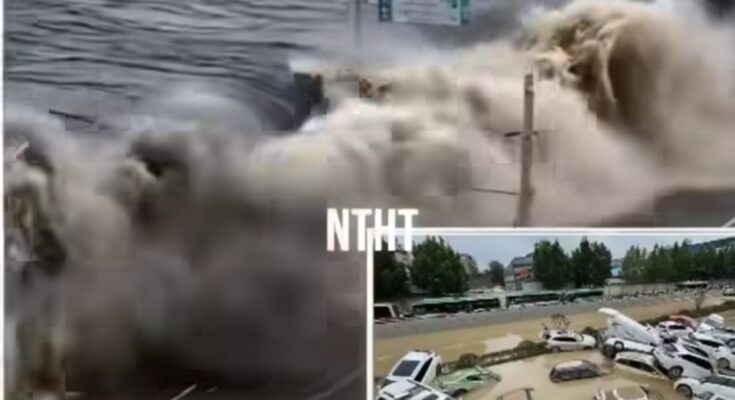Hurricane Barbara continues its path. Where is it and where is it heading? Hurricane Barbara continues with sustained winds of 120 km/h and gusts of up to 150 km/h, enough to damage structures and cause power outages.

Credit: SMN
Hurricane Barbara is already making its presence felt off the Mexican Pacific coast. Having become a Category 1 hurricane, it is moving northwestward, leaving torrential rains, violent winds, and rough seas in its wake in the states of Jalisco, Colima, Michoacán, and Nayarit.
On Monday, June 9, 2025, the National Meteorological Service (NMS) and the U.S. National Hurricane Center confirmed that Barbara has reached hurricane strength, with sustained winds of 120 km/h (75 mph) and gusts of up to 150 km/h (93 mph), speeds sufficient to topple trees, damage light structures, and cause power outages.
At 3:00 PM Central Mexico Time, Barbara was located 230 kilometers (145 miles) southwest of Playa Pérula, Jalisco, and 280 kilometers (170 miles) west-southwest of Manzanillo, Colima, moving northwest at 17 km/h (10.6 mph). Its path is keeping it relatively close to land, increasing the risk to coastal communities.
Fierce waves and dangerous rainfall
The hurricane’s cloud bands are spreading widely, generating very heavy rains in Jalisco, Colima, and Michoacán (25 to 50 mm), as well as showers in Nayarit (5 to 25 mm). This rainfall could lead to landslides, river and stream overflows, and flooding in low-lying areas.

Credit: X
The wind is also increasing. Gusts of up to 80 km/h (50 mph) are being recorded along the coasts of Jalisco and Colima, and gusts of up to 60 km/h (37 mph) in Michoacán and Nayarit. Added to this are dangerous waves of 3.5 to 4.5 meters (11.8 to 15.7 feet) in Jalisco, Colima, and Michoacán, and up to 2.5 meters (8.2 feet) in Nayarit.
Experts emphasize the seriousness of these conditions. The sudden increase in river flow, combined with soil saturation from previous rains, poses a real threat to rural and urban communities.

Credit: XCivil Protection on alert: Do not let your guard down
Mexican authorities urge the population to follow official communications from the National Meteorological Service (SMN) and Civil Protection, and to stay away from beaches, mountainous areas, and bodies of water that could overflow.
Although Hurricane Barbara has not yet made landfall, its proximity is sufficient to generate high-risk conditions throughout the central-western region of the country. Temporary shelters have been set up in several coastal towns, and it is recommended that emergency backpacks be prepared, evacuation routes identified, and unnecessary travel avoided.

Credit: XWhat’s happening with Tropical Storm Cosme?
Meanwhile, another threat lurks in the ocean: Tropical Storm Cosme, located approximately 975 kilometers south-southwest of Cabo San Lucas, Baja California Sur, with sustained winds of 110 km/h (68 mph) and moving northwest. Despite its power, Cosme does not pose a direct threat to Mexico due to its remoteness, although its evolution remains under surveillance.
You may be interested in > Storm Barbara becomes a hurricane: Torrential rains and waves in these states

Credit: SMNBBarbara is a warning: Climate change intensifies hurricanes
The 2025 Pacific hurricane season is already showing its strength, and Barbara is just the beginning. According to meteorological experts, the warming of ocean waters, fueled by climate change, is leading to more frequent, intense, and destructive hurricanes.
A 9.1 magnitude earthquake also caused a tsunami in the city of… See more
A 9.1 magnitude earthquake also caused a tsunami in the city of… See more
Tokyo, Japan – Japan has been rocked by the most powerful earthquake in 140 years, leaving a trail of destruction, anguish, and an entire country in a state of emergency. The 8.9 magnitude quake struck early Tuesday morning, with its epicenter off the country’s northeast coast, near Miyagi Prefecture.
The tremor, which lasted more than a minute, caused entire buildings to shake violently in Tokyo, more than 300 kilometers from the epicenter. Seismic alarms were triggered across the country, allowing many people to evacuate in time, but it was not enough to prevent the tragedy.

So far, authorities have confirmed more than 3,000 deaths and thousands are missing. Aerial images show coastal towns completely devastated by a tsunami following the earthquake, with waves of more than 10 meters sweeping homes, cars, and boats inland.
Japan’s prime minister, in an urgent press conference, declared a state of national disaster and urged the population to remain calm. “This is a disaster of historic magnitude. But Japan has risen again before, and it will do so again,” he stated resolutely.
Hospitals in the affected areas are overwhelmed, and thousands of people have sought refuge in makeshift shelters. More than 1.5 million homes are without electricity, and food, water, and basic necessities are in short supply. Self-defense forces, along with international rescue teams, are working tirelessly to find survivors under the rubble.
One of the greatest concerns following the earthquake is the situation at several nuclear plants in the region. In particular, the Fukushima nuclear plant has reported severe damage to its cooling systems, raising global alarm over a possible radioactive leak. Authorities have evacuated a 20-kilometer radius around the plant and are constantly monitoring radiation levels.
Seismology experts have described this event as the worst since the Great Kanto Earthquake of 1923 and the strongest recorded since modern scientific records. According to the Geological Survey of Japan, the energy released by this earthquake is equivalent to hundreds of atomic bombs like the one dropped on Hiroshima.



